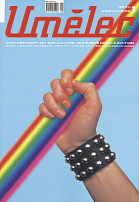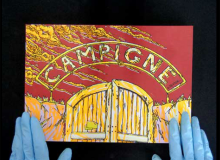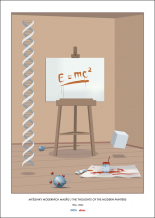| Umělec magazine 2001/1 >> Unveiled Beauty | List of all editions. | ||||||||||||
|
|||||||||||||
Unveiled BeautyUmělec magazine 2001/101.01.2001 Karel Císař | artist | en cs |
|||||||||||||
|
"There is no doubt today that art historian Jan Avgikos was correct two years ago when she claimed that one of the images that would always remind us of the 1990s was of a formation of twenty girls in Tom Ford’s Gucci bikinis, or without them, standing still at the center of the New York Guggenheim’s rotunda. On 23 April 1998 about 500 invited guests were lucky enough to see Show, the work of the 29-year-old Italian artist Vanessa Beecroft.1
Paradoxically, what made the biggest impression was not Beecroft’s performance itself or Doug Aitken’s video recording of it or the photographs by Annika Larsson and Polaroids by Vanessa Beecroft. It was actually the unique frontal photograph VB 35.377 taken by Mario Sorrenti. The picture ideally combined all the antagonistic qualities that are characteristically present in the young Italian star’s work, despite the fact that Beecroft herself considers recordings of her installations to be nothing more than snapshots, postcards, souvenirs,2 really only the logical result of the thinking behind her work, which persistently questions the role of reality in contemporary art, or the nature of reality itself. The constant awareness of the artist as a “medium” makes this kind of questioning possible. An unexpected accord between Vanessa Beecroft’s latest interview and a key section of Marcel Duchamp’s lecture from 1957 “The Creative Act in the Museum of Art” in Houston may prove the point. While in the presence of Rudolf Arnheim and Gregory Bateson, Duchamp first articulated his idea of the artist as a “medium.” To Munro Galloway’s question of whether there was hidden strategy in the shift of the performers from ordinary, usually half-clad women to completely naked professional models, Vanessa Beecroft surprisingly answered that she had a clear idea of the performers right from the start: They were supposed to be naked girls with an Irish or British look, wearing Manolo Blahnik shoes. Every other detail should be considered a mistake, which, she says, the performances are full of. In 1995, Beecroft asked five girls to pose naked but they refused. When she later asked producer Yvonne Force to get twenty naked girls for Show at the Guggenheim, she only got five because the others were only willing to pose if clothed. The selection of shoes told a similar tale. The first to supply her with free footwear was Prada in 1995. And instead of Chanel shoes for her performance BV 16, she only got Todd Oldham. Beecroft considers all these to be mistakes: “It’s like when you do a drawing and it’s too large or too small. In the performances, when the girls are wearing funny shoes or bad sweaters, or if they are too short or too tall — for me those are mistakes. It was far from what I wanted. In the recent performance at the Gagosian Gallery in London, the girls were beautiful, but there was still some imperfection. I like working with commissions and compromise, it’s more interesting. In the end the work is more realistic and sophisticated.”3 This very aspect of Vanessa Beecroft’s work could be interpreted as the strategic use of the initially unconscious difference between the intention and its realization, the arithmetical relationship that makes up an “art coefficient.” “Consequently, in the chain of reactions accompanying the creative act, a link is missing. This gap, representing the inability of the artist to express fully his intention, this difference between what he intended to realize and did realize, is the personal art coefficient contained in the work.”4 Abandoning full control over one’s work has, in Beecroft’s case, a more profound nature. It concerns not only the selection of girls and their clothing but also the performance itself. Beecroft sets out only three elementary rules: The girls cannot move abruptly; they shouldn’t speak; and they cannot contact the audience in any way, including eye contact. Viewers are thus confronted by a group of more or less naked girls who initially stand still, assuming indifferent positions, and the whole thing looks like something between fashion and a military parade. Depending on the individual performers’ stamina throughout the performance, which usually lasts for more than two hours, the formation slowly alters without any external impulse. Wearing uncomfortable high-heeled shoes, the girls shift their weight from one leg to another; they slowly stretch their backs and after some time they sit or lie on the floor only to return once again to their original positions. Beecroft says that she does not expect the girls to give more than 50 percent of themselves in an event that she herself does not participate in. She also says that she only documents the performance, and, unlike her long-time photographer Armin Link, focuses on taking snapshots that portray the expressions of the performers. In addition to the purely formal nature of her individual performances, Beecroft’s noncommittal attitude is evidence of further harmony between her work and Duchamp’s lecture. The intentional surrender of control over the effect of the performance, and the intentional transfer from the artist to the viewer of the responsibility of discovering the work’s meaning all bring her closer to the essence of Duchamp’s essay. In the end, it is up to the viewer to determine the meaning of such an open work. As in the original example, we can again speak of a certain escalation of Duchamp’s original viewpoint, which states that “the creative act is not performed by the artist alone; the spectator brings the work in contact with the external world by deciphering and interpreting its inner qualifications and thus adds his contribution to the creative act.”5 In Beecroft’s case, it is the personal nature of experiencing her performance that guarantees this transfer of the focal point of creation from the artist to the viewer. For this reason, reflections on her performances often take on a private tone.6 It seems that everybody who has witnessed one of her performances experienced something different, despite the fact that they all saw the same show. The basic concept has remained the same since her first exhibition in Milan’s Inga-Pinn Gallery in 1993. She only invited specially selected and dressed peers to her exhibition of diary drawings and texts. Slight differences in the number of performers, their clothing and make-up and the spatial organization of the group are naturally given as much notice with Beecroft as obviously dramatic turning points would be in the work of any other artist. In VB 08 at P.S. 1, New York, eleven girls wore the bright red wigs that had first made their appearance in Beecroft’s paintings. In VB 11 in Analix Gallery, Geneva, the girls struck a Cartesian pose with one girl wearing white underwear and two girls sitting in dark suits as a backdrop.7 In the breakthrough performance VB 16 in Deitch Projects, New York, two girls in raincoats and one girl wearing a green dress sat in the foreground with a group of eleven girls wearing underwear in the background. A now famous photograph of a girl’s face with a golden tooth, VB 16.009, which is part of the Lamber Art Collection, provided the documentation of the performance. In VB 21 at Massimo de Carlo Gallery in Milan, Italy, two clothed men appeared in a performance for the first time. In VB 23, three girls posed in Manolo Blahnik shoes at the center of a space with an abstract painting from the permanent collection of the Ludwig Museum in Cologne. In VB 28 at the Venice Biennale, girls wearing underwear strutted catwalk-style past photographs of previous Beecroft performances. In VB 29 at Le Nouveau Museé in Lyon, a single model in underwear made from an American flag posed exclusively for the camera. In VB 33 at ICA, London, three girls posed in pumps and gray sweaters, naked from the waist down. In VB 34 at Moderna Museet, Stockholm, of the nine girls, the bare-chested held American flags. In VB 35 at the Guggenheim, New York, five of the twenty girls were completely nude for the first time. In VB 36 at the Contemporary Art Gallery in Leipzig, Germany, all four participating girls were naked. In VB 42 in San Diego, Beecroft composed a unit of American marines in groups of three and dressed them in their white civilian uniforms. On February 16, Vanessa Beecroft organized her biggest performance to date, VB 45, for the opening of the new Kunsthalle in Vienna. It featured 45 young women wearing high Helmut Lang shoes. In addition to the number of models, this performance also differed from the previous in the sheer variety of individual body types. While the selection of performers in the past typically made an effort to unify the body type of the group, an effect emphasized by heavy make-up and wigs, viewers at the Viennese performance were not confronted by unreal women with ideal proportions but rather by women whose virtuality (unreality) was ensured by their nudity. Placed according to the space, the group was organized in rows of five, creating a kind of minimalist sculpture. A formal analysis would symmetrically divide the sculpture’s mass into a dark lower layer, consisting of the high-heeled shoes, and the light upper layer, the nude bodies. At the same time the sculpture determined how the viewers moved as they flocked around it. They were drawn into the symbolic space of the performance where they formed an opposition to the exhibited women. They looked without being seen themselves, and not because they were concealed but because they were being ignored. A gap opened between the world of the viewers and the models, a gap that prevented any interaction. The organized formation of women followed its own autonomous rules as it became part of an art world traditionally perceived as something untouchable, exhibited solely for unbiased, esthetic contemplation.8 These specifically selected women were more real than ever before, but the nudity and organization in space transformed them into a new and many-headed virtual being that lived its own abstract life only to shatter back into 45 bodies after a few hours. As if they had never existed before. “For me the performance is brief, ephemeral, and that’s what I’m interested in. The feeling you get when it’s over, and you don’t even remember exactly how it was. You remember it as being more beautiful, and the photographs are proof that beauty lies in the memory. It’s sad to see the photographs after you remember the event. My work is really the performance. I consider the photographs to be like snapshots, postcards or souvenirs.” Translated by Vladan Šír Notes: 1. Cp. Jan Angikos, Let the Picture Do the Talking, Parkett 56/1999. 2. Cp. Les mises a nu de Vanessa Beecroft, interview par Munro Galloway, Art Press 265. 3. Ditto, p. 25. 4. Marcel Duchamp, The Creative Act, Art News, 4/1957. 5. Ditto. 6. Wayne Koestenbaum and Edward Leffingwell in their texts on Vanessa Beecroft’s performances mention what the weather was like the day they saw the performance. Cp. Wayne Koestenbaum, Bikini Brief, Art Forum 10/1998 and Edward Leffingwell, Art in America. 7. Cp. Giacinto Di Pietrantonio, Vanessa Beecroft, Flash Art Int. 183/1995. 8. Cp. Dave Hickey, Vanessa Beecroft’s painted ladies, in: VB 08-36, Hatje Cantz, New York 2000. "
01.01.2001
Recommended articles
|
|||||||||||||
|
04.02.2020 10:17
Letošní 50. ročník Art Basel přilákal celkem 93 000 návštěvníků a sběratelů z 80 zemí světa. 290 prémiových galerií představilo umělecká díla od počátku 20. století až po současnost. Hlavní sektor přehlídky, tradičně v prvním patře výstavního prostoru, představil 232 předních galerií z celého světa nabízející umění nejvyšší kvality. Veletrh ukázal vzestupný trend prodeje prostřednictvím galerií jak soukromým sbírkám, tak i institucím. Kromě hlavního veletrhu stály za návštěvu i ty přidružené: Volta, Liste a Photo Basel, k tomu doprovodné programy a výstavy v místních institucích, které kvalitou daleko přesahují hranice města tj. Kunsthalle Basel, Kunstmuseum, Tinguely muzeum nebo Fondation Beyeler.
|



































 New book by I.M.Jirous in English at our online bookshop.
New book by I.M.Jirous in English at our online bookshop.
Comments
There are currently no comments.Add new comment